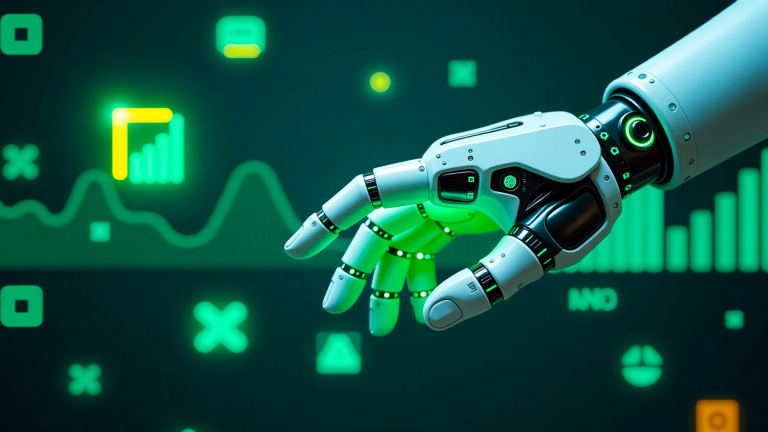Editor’s note: “Steve Jobs Dreamed it. Elon Musk Is Making it Fruitful.” was previously published in July 2025 with the title “Steve Jobs, Elon Musk, and the Most Lucrative Invention of the Century.” It has since been updated to include the most relevant information available.
We all know about Steve Jobs: the leadership, the turtlenecks, the gadgets he helped bring to life that went on to reshape nearly every facet of our lives – the iPhone, the Mac, the iPad.
He was one of the greatest innovators of our time, guiding Apple (AAPL) to become one of the most profitable companies of the century.

But what if I told you there’s a Steve Jobs story you’ve never heard – one that might be his most ambitious dream of all?
It was a vision so daring that it aimed not just to sell a new product but transform America itself; bring back prosperity, rebuild forgotten towns, and free the country from its dependence on foreign factories.
We’re talking about an aspiration with economy-transforming potential…
Steve Jobs’ Hidden Dream: Advanced Manufacturing at Home
In the late 1980s and early ’90s, while other CEOs were shipping jobs overseas, Jobs was deeply worried.
He saw that America’s industrial heart was being hollowed out; that the knowledge of how to make things was leaving our shores. And he knew that, once gone, it might never come back.
For Jobs, manufacturing wasn’t just about assembly lines. It was about innovation. When a nation stops building, it stops inventing. It becomes dependent; vulnerable. And that terrified him.
So, the Apple co-founder hatched a plan. He called it his next revolution: a vision for advanced factories where human and robot workers create the future together, right here in America. He dreamed of high-paying jobs, revitalized Rust Belt towns, and a nation in control of its destiny once again.
In 1990, Jobs built a prototype factory in California. The idea? Use cutting-edge automation to make American workers so productive they could outcompete cheap overseas labor. Robots would handle the repetitive work while people run the show. It was genius.
Except the world wasn’t quite ready for this idea to be realized. The tech wasn’t there. The economics didn’t pencil out. And when Jobs passed in 2011, many thought his most audacious dream died with him…
But it didn’t.
It’s being brought to life right now, powered by technologies Jobs could only imagine during his lifetime – and driven by the one entrepreneur bold and dedicated enough to finish what he started: Elon Musk.
Elon Musk’s Optimus Steps In With Robots That See, Think, and Build
The man who made electric cars sexy, privatized space travel, and wants to put chips in your brain has taken up Jobs’ mantle – and he’s supercharging it.
Where Jobs had clunky robots and primitive AI, Musk has Tesla’s (TSLA) Optimus: a humanoid robot that can see, think, and move with uncanny precision. Thanks to advances in AI, sensors, and materials science, Musk has cracked the code Jobs never could.
Tesla’s gigafactories already have these robots at work, carrying parts, assembling components, and charging themselves when needed.
And these aren’t million-dollar prototypes. Musk says they’ll cost under $20,000 apiece. That’s less than what some companies pay per year for offshore labor.
Optimus does what Jobs dreamed of: makes reshoring not just patriotic but profitable.
Robot Reshoring: Productivity, Prosperity, and New High-Wage Jobs
In our view, this robot is a game-changer – one that could end the era of offshoring and bring manufacturing roaring back to American soil.
Imagine factories where robots do the grunt work – tirelessly, flawlessly, 24/7 – while human workers move into high-skill, high-pay roles like programming, supervising, and maintaining.
Imagine the Rust Belt reborn, with jobs flooding back and towns revitalized.
Today, it’s more than a fantasy. It’s the plan.
And the economics are undeniable… because when a robot costs less than a single offshore worker, works all day and night, and produces zero defects, why keep factories overseas?
Optimus is actively rewriting the logic behind global supply chains. It’s no wonder politicians of all stripes are drooling over it.
Trump’s “America First” vision now seems more like an inevitability. And this isn’t just about replacing jobs. It’s about transforming them.
History shows that automation often creates more jobs. For example, when ATMs launched in the 1970s, experts worried they would eliminate bank-teller roles. But that didn’t happen. Instead, as automation lowered the cost of running branches, banks opened more of them – and teller employment rose from around 300,000 in 1970 to 600,000 by 2010.
Economists call this a “compensation effect.” Automation reduces unit costs, spurring demand for services and supporting new roles – especially those involving human interaction and problem-solving.
That’s why we expect that for every fleet of robots, we’ll need several human workers to program, maintain, and supervise them. And beyond that, there should be a ripple effect for component suppliers, software developers, infrastructure workers, and more.
In other words, as Tesla’s Optimus scales, we’re likely to see growing innovation hubs, supplier networks, and regional career ecosystems, rekindling the kind of job-rich rebounds seen in past industrial shifts.
Finding Tomorrow’s Winning Tech Firms In the Optimus Supply Chain
Still skeptical? Let’s talk numbers:
- Tesla has already begun deploying Optimus internally; in fact, at its recent unveiling of the Tesla Diner in Hollywood, it revealed that Optimus is now employed in the real world, serving popcorn to customers and seeing them off with a wave or a peace sign.
- Elon Musk has said Tesla expects to have “thousands” of Optimus robots working in its factories by the end of 2025, and later mentioned a target of 5,000 units, with parts capacity reaching 10,000- to 12,000 robots.
- Production could scale quite quickly after that, so long as the company doesn’t encounter too many headwinds with sourcing necessary materials.
- As such, Tesla’s market cap, fueled by Optimus, could rise from $1 trillion today to $25 trillion by 2030. Now, that may be partly wishful thinking – but it is also Musk’s roadmap, and Wall Street is starting to take notice.
And it’s not just Tesla that wins if that’s the case.
Every revolution has its ecosystem. Just as the iPhone created fortunes for component suppliers like Skyworks (SWKS) and Cirrus Logic (CRUS), Optimus will likely mint new industrial titans as demand for chipmakers, sensor suppliers, actuator specialists, and materials innovators takes off.
Indeed, since Optimus isn’t built from off-the-shelf parts, Tesla is creating an entirely new supply chain, from neural vision chips to exoskeleton materials.
That means dozens of small, specialist companies are about to go from obscure to essential.
Think about that potential. If you’d known Apple’s supplier list before the iPhone launched, how rich would you be today?

That’s the opportunity on the table right now – if you act before Musk starts naming names as Optimus production scales up.
The Robot Revolution Is Real – Will You Watch or Profit?
Why now?
Because we think the stars have finally aligned:
We have technological readiness. AI, robotics, and materials science have advanced to the point where humanoids are viable tools.
There’s political will, too. We have bipartisan hunger for reshoring, with Optimus seemingly offering the ultimate solution.
And there is economic necessity. The COVID-19 pandemic exposed the fragility of global supply chains. Now both companies and governments want control back.
Folks, we may actually be living through the opening chapter of a story that will be told for generations.
Jobs dreamed it. Musk is building it. And for those with the foresight to act now, the potential rewards could be enormous.
This isn’t just a product cycle or even the birth of a new industry. It’s the dawn of a new era – one where America reclaims its industrial might, powered by intelligent robots that work alongside us.
Optimus is already here. The only question is: will you watch this revolution unfold from the sidelines… or will you be part of it, profiting along the way?

